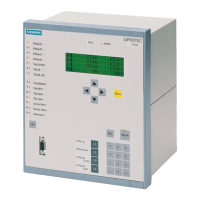'(& )( )'& &) ( &!& ")& &$(( $# Ċ %&( $# #)" &&#$
X
X - I
Siemens AG ⋅ May 1998
Abbreviations, A - 32
Alarms,6-24
Fault events - block 72,6-32
Introduction,6-24
Isolator,6-28
Marshalling
binary outputs,6-25
LED-indications,6-25
Measured values for commissioning - block 74, 75, 76, 78,
6-30
Operational event recording - block 71,6-28
Supervisory events,6-28
Ancillary Functions,4-26
Alarm relays and indications,4-31
Bay out of service,4-30
Event logging,4-31
Fault recording,4-32
Feeder-selective trip release,4-26
Minimum duration of the trip command,4-26
Monitoring functions,4-32
Operation and indication,4-31
Overcurrent controlled trip command,4-26
Supervision
CB failure protection initiation,4-35
CB failure protection release,4-35
Current-controlled reset of the TRIP command,4-36
Cyclic test,4-37
Differential curent supervision for linearized current transĆ
formers,4-37
differential current supervision,4-34
external CT circuits,4-34
Isolator supervision,4-35
Software,4-33
Ancillary functions
General data,3-6,3-7
Supervision, Hardware,4-32
Appendix,A-1
Application,2-1
Applications functions, Overview,4-3
Available operational and fault events,A-3
Basis for selection of the stabilization factor k,A-11
Bus coupler
Recognition of a circuit breaker disturbance,4-29
Recognition of status OPEN,4-28
Recognition of the closing command,4-28
Bus coupler bay, Detection of short-circuit in the "dead zone"
of the bus coupler,4-27
Busbar protection,3-5,4-4
Basic principle,4-4
Response threshold, pick-up,4-10
Separate evaluation of half-cycles,4-7
Stabilization,4-5
Summary of the measuring method,4-10
Weighted evaluation of the initial values,4-9
Circuit-breaker failure protection,3-6
busbar faults,4-24
during a feeder short-circuit,4-18
General data,3-6
Initiation by external,4-24
Pulse mode,4-23
TRIP repetition with current sensor,4-19
Unbalancing,4-20
with current sensor,4-18
with TRIP repetition,4-21
with unbalancing,4-21
circuit-breaker failure protection,4-18
Circuit-breaker protection, Failure of the bus coupler circuit
breaker,4-25
Commissioning with primary values,6-59
Checking the alarms and trip signals,6-60
Checking the connections of the circuit-breaker failure proĆ
tection initiation inputs,6-60
Checking the current transformer polarity with load current,
6-59
Switching the protection into service,6-60
Communication software DIGSI,6-2
Configuration examples,5-9
Connection diagram, Master unit,A-14
Connection diagrams
bay unit,A-12
Master unit,A-13
Connections, Overview,2-10
Connections diagrams,A-12
Data for selection and ordering,1-2
Design,2-8
Device connections,2-10
Fitting of the modules,2-9
Device settings,6-36
Dimensions,2-11
Bay unit,2-11
Master unit,2-14
Event records, Block 71 to 76 and 78/ZE - Examples,A-1
Fault analysis,7-2
Analysis, Failures in the communication ZE-FE,7-10
Analysis of operational events,7-2
Check of the LEDs on the modules,7-5
Checking the auxiliary voltage supply,7-3
Replacement of fuses,7-3
Fault indication and analysis, Analysis, Fault buffer,7-6
Features,2-2

